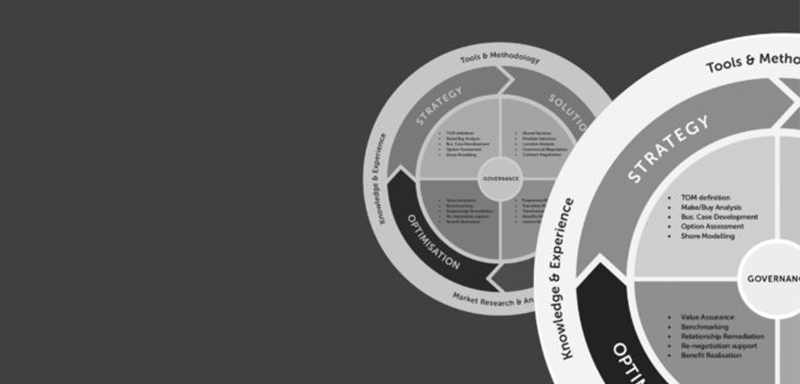
WE HELP OUR CLIENTS USE OUTSOURCING AS A TRANSFORMATIONAL LEVER TO DELIVER STEP-CHANGE IMPROVEMENTS.
Introduction to Outsourcing
Outsourcing today is an established part of the operations toolkit, a lever for transforming IT and operations, driving step-change cost savings and improving quality of service. It can be quite an emotive proposition, but love it or hate it, Outsourcing is a permanent part of today’s business environment.
In its simplest form, Outsourcing is the transfer of a business function, process, or activity to a third-party Service Provider, and that may include the transfer of people and assets. This transfer of responsibility, albeit not accountability, for delivery may then be undertaken onshore, near-shore, or offshore, and by one or more Service Providers depending on the Sourcing Strategy.
IT Outsourcing (ITO) is a highly mature market, whereas Business Process Outsourcing (BPO) is considered to be a more recent phenomenon, although its roots can be traced back to the 1990’s, and as an industry it continues to grow rapidly and broaden in capability.
Benefits of Outsourcing
The primary driver for Outsourcing has traditionally been to deliver step-change cost reduction, and while this remains true today, increasingly secondary benefits are becoming as important;
- Cost Reduction – Outsourcing Providers will use a range of cost reduction levers to deliver lower committed cost to the customer. These levers include economies of scale, wage arbitrage, process re-engineering, deployment of transformation tools (eg. RPA, CI, DA), reducing spans of control, de-skilling roles, and lower company overheads.
- Service Improvement – Contrary to some opinion Outsourcing can and often does lead to a positive step-change in the performance and quality of services. This may be in the consistency of performance, optimised delivery model, improved standardisation and simplification of processes, service windows, application of best practice, or the leveraging of an Outsourcing provider’s investment in tools and resources. – Proving that cost reduction and service improvement do not have to be mutually exclusive.
- Speed to Market – Outsourcing may enable customers to get new products or services to market quicker, or to deliver operational change quicker. This may be either in the establishment of an off-shore service delivery centre whereby the Outsourcing Provider has the infrastructure already in place, or to use the Outsource Provider to develop or produce a new product to test the market, or to use them as an enabler to quickly and cheaply enter a new geographic market.
- Avoided Investments – A driver for Outsourcing may be to avoid a significant investment cost that is non-core to the business. By Outsourcing it may mean significant capex or opex spend can be avoided. Some typical examples include: re-fitting a Data Centre, the need to buy or lease another building, purchase of a major asset, or the need to build a capability in a particular non-core function for either a temporary or long-term requirement.
- Access to Skills and Capability – It can be difficult for businesses to obtain and retain specific skills and resources. This may be due to scarcity in the market, lack of career path opportunities, cost, or while required, the demand may be temporary or not full time. Outsourcing Providers can provide customers with access to a breadth and depth of flexible resourcing and wider capabilities that cannot be readily found within the customer itself.
- Access to Emerging Technology – As Outsourcing Providers continue to invest in and develop new technologies and look to leverage market leading technologies in the pursuit of operational improvement, they can provide customers with access to these tools quicker, cheaper and more easily. eg. new ERP systems, digital workflow tools and Robotics (RPA).
- Increased Flexibility – Outsourcing can provide increased flexibility and organisational agility at both a macro and micro level. Outsourcing Providers are better placed to be able to ramp up/down service and capacity to meet demand, adjusting to changes in volume quickly and efficiently. This in turn also provides the customer with the ability to integrate acquisitions and potentially manage divestments more efficiently.
- Greater Focus on Core Business – Outsourcing non-core, non-differentiating services, processes and activities allows the customer leadership to focus on its core business. It enables the customer to invest its time and resources in its customers and ‘go-to-market’ offerings without distraction.
- Financial Optimisation – Outsourcing, can help move Captial expenditure (Capex) to Operating expenditure (Opex) and to move fixed costs to variable costs that align better with demand. It can also increase cost predictability, particularly if there is a multi-country aspect and Foreign Exchange (FX) risk is transferred to the Service Provider. In some cases, it can provide greater cost transparency and better alignment with cost levers – over and above in-house operations. It may also be a vehicle for removing capital intensive assets from a customer’s book, for example IT investments and buildings.
- Change Agent – Outsourcing Providers can provide the catalyst for Change or indeed be the agent of Change, transforming businesses and operations. They can remove the upfront investment required, provide the necessary skills, tools and resources, and deliver committed underwritten outcomes in an often a faster timeline.
Scope of Outsourcing
Outsourcing has moved way beyond the first generation of Outsourcing agreements which were often based on a staff augmentation model and focused purely on levering wage arbitrage benefits by delivering from lower cost locations. Today’s generation of Outsourcing agreements are now far more service centric – focused on delivering outputs and outcomes by pulling a range of transformation levers to deliver benefits including 6sigma, LEAN, RPA, Cognitive Intelligence, span of control, process simplification and standardisation as well as lower cost locations.
There are many variations to Outsourcing scope, however Outsourcing scope can generally be categorised into the following areas;

It should be noted that Legal Process Outsourcing (LPO) and some industry-specific Outsourcing are also sometimes referred to as Knowledge Process Outsourcing (KPO) in recognition that they involve a level of judgement and knowledge not typically found in purely transaction based operational processes.
There are also a variety of ‘hybrid’ Sourcing models which blur the boundaries between Outsourcing, Shared Services, and Inhouse/Captive operations, including ‘Build Operate Transfer’ (BOT) and ‘Hoteling’, the use of which may be driven by a specific Client objective. As with all models there are strengths and weaknesses to each of them, the focus should be in considering what is right for you recognising your potential challenges, constraints, and opportunities.
Challenges of Outsourcing
Outsourcing if not done properly, can and will fail. High profile failures are readily seized upon by the media, but it belies that the majority of Outsourcing programmes are broadly successful and do not end up in messy public ‘divorces’.
Where outsourcing programmes fail, it is invariably the result of a poorly thought through Strategy, poor execution, or a combination of both of these. The chances of success improve exponentially if there is;
- The right control, sponsorship and direction.
- An appropriate focus on Commercial and Legal Risk Management.
- A contractual agreement that drives the right behaviours in both parties that supports a win:win outcome.
- A well-planned Transition with appropriate focus on risks and dependencies.
- Effective Service Management and Governance put in place.
For some there are concerns relating to the expectation of loss of control, ability to flex/change, the impact on individual staff, and the fear of the unknown. These concerns should not be readily dismissed but need to be properly addressed and can be.
If Outsourcing is done properly, then the risks can be mitigated and minimised to the extent that the probability and impact of an occurrence is virtually non-existent and certainly inconsequential in comparison to the benefits that can be derived.
Leveraging Outsourcing
Hillbrooke can help you to balance the risks with the benefits, providing practical learnings to minimise and mitigate risks, ensure regulatory compliance (where appropriate) and maximise the benefits. – Talk to us.
IT Outsourcing (ITO)
Outsourcing is considered to be highly mature in the IT function and today IT Outsourcing (ITO) represents a global multi-billion dollar market, one that continues to evolve and grow. Indeed since ITO’s emergence in the early 1980’s, it has become the defacto standard approach for firms to Source IT services, albeit the extent to which IT services are Outsourced and how they are Outsourced can vary significantly from organisation to organisation.
The way in which IT is Outsourced has changed dramatically over time reflecting advances in technology and telecoms, the emergence of new technologies, and the development of new commercial and operating models.eg. offshore delivery centres, cloud-computing, data connectivity, Software-as-a-Service (SaaS).
IT Outsourcing providers are continuing to grow and invest in new skills, new competencies, and new technologies. The growth in Cloud deployment coupled with emergence of technology such as the Internet of Things (IoT), Data Analytics, and Blockchain will mean that companies will increasingly look to IT Outsourcing providers to provide the necessary skills and provide scalable solutions at pace. As the shortage in IT skills in the market intensifies more organisations will look to outsource activities previously retained to leverage the outsourcing providers resource pools.
Historically, cost was the biggest driver in IT Outsourcing, whereas today, while it remains a key element, the focus is increasingly on the value delivered with an even greater focus on productivity, quality, speed, and security.
Increasingly Outsourcing agreements are becoming more output/outcome focused, transparent and flexible at both a macro and micro-level, and often with the provider putting more ‘skin in the game’. Application Development work alone may now be provided on the basis of several different commercial and delivery models depending on what is right for any one specific programme.
There continues to be a challenge to manage how to integrate an increasingly multi-sourced IT environment, with service tower models. This is being further complicated by SaaS provision, convergence technology, changes in workplace practices and technologies, and the exploding use of niche applications in the business beyond the enterprise platforms. Service Integration (or SIAM) has been increasingly critical to ensure the effective delivery of services across the enterprise.
The IT Outsourcing role is set to continue to develop and expand in the IT function. Let us help you take advantage of the benefits and get the most out of your IT Outsourcing arrangements. Talk to us.
Business Process Outsourcing (BPO)
Business Process Outsourcing (BPO) is considered a more recent phenomenon although its roots can be traced back to the 1990’s. Since then, it has developed dramatically as businesses have looked to transfer non-core, non-differentiating functions, processes and activities to low cost specialist third-party Service Providers for whom it is their core business capability – one they invest in and work hard to optimise.
While many would consider that the initial BPO industry focus on the Outsourcing and offshoring of customer contact centres in the 1990s was poorly conceived and executed (and indeed for some organisations it was a mistake), now these types of contact centre activities are much more mature and represent a mere ‘drop in the ocean’ relative to the currently large and thriving BPO industry.
Today over a million staff globally provide BPO services across a range of back office functions including Finance & Accounting, HR, Procurement, and Legal, along with an increasing range of middle office industry specific functions from claims processing for Insurance firms to mortgage processing for Banks.
Although the success of BPO has been built on low level, high volume, transaction-based processing, increasingly services are moving up the value chain into judgement-based activities such as delegated underwriting and actuarial services in Insurance. This is something that for many would have been considered inconceivable even just 10-15 years ago.
BPO is continuing to evolve as the threat of Robotics (RPA), Cognitive Intelligence, and Data Analytics looks to disrupt the vast manual based transaction factories that have been created. The Service Providers have embraced these emerging technologies re-positioning themselves as Transformation agents, and with it, the BPO industry is morphing into what is now being dubbed BTO (Business Transformation Outsourcing).
Let us help you leverage the benefits of Business Process and Business Transformation Outsourcing. Talk to us.






